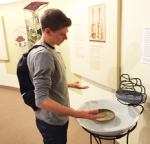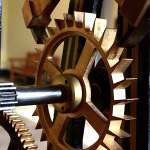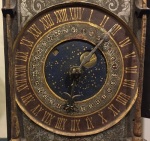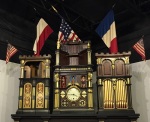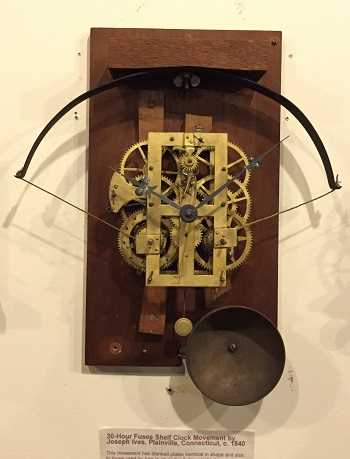
30 hour spring powered fuse shelf clock, National Association of Watch and Clock Collectors Museum.
Set in the heart of Pennsylvania’s early American clock making region, the National Association Watch and Clock Collectors museum in Columbia, Pennsylvania is worth a visit. Their collection spans from some of the earliest European and Asian clocks and watches to modern-day wrist watches and mystery clocks. They even have a wonderful display of the under-appreciated lathes and machinery that helped propel America as the center of quality pocket watch production in the 19th and 20th century. (Videos of Engle monumental clock and Seth Thomas tower clock at end of post).
Watch and clock museum day trip
On a trip to visit East Coast colleges with my son we had a free day and decided to make the long trek from Philadelphia to Columbia, PA where the National Association of Watch and Clock Collectors (NAWCC) museum is located. In general, for a novice clock collector like me it was time well spent. However, for most people the museum doesn’t offer enough basic historical background about American clocks or watches to warrant a ninety minute drive one way.
Mass production successfully applied to clock making
From a historical perspective, clock making in the United States tracks closely with our pattern of industrial dominance in many different industries. From the first mass-produced inexpensive wooden clocks by Eli Terry to the highly precise yet affordable pocket watches used in the railroad industry, the creation of American time pieces is unique to our history. Connecticut clock maker Eli Terry was known as an inventive craftsman. In 1807 Terry accepted an offer to build 4,000 wooden clock movements within three years.
“Terry was happy to supply the movement, dial, hands, weights and pendulum, but not the case. Eli’s son Henry recorded: “Three years elapsed while these clocks were being made. A great part of the first year was spent in fitting up the machinery, the next in the manufacture of one thousand clocks, and the third year in completing the remaining three thousand. To assist him in the project, Terry hired two joiners, Seth Thomas and Silas Hoadley.
It was during this time that Eli Terry made is greatest contribution to clockmaking: adapting the craft to true mass production.” – Two Hundred Years of American Clocks and Watches by Chris Bailey
Uniquely American banjo clocks
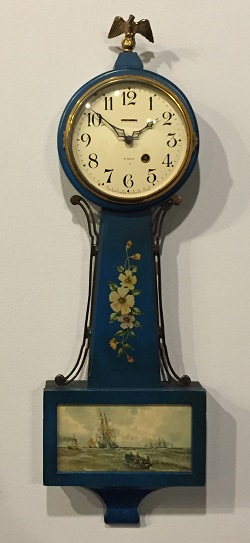
Banjo clock inspired by Simon Willard’s original “Improved Timepiece” of 1802, National Association of Watch and Clock Collectors Museum.
There is little mention of Simon Willard who designed the American classic known as the banjo clock.
“On February 8, 1802, a patent was granted, and Willard’s “Improved Timepiece” became one of the best known American clocks. It brought him acclaim during his lifetime and immortality in the field of horological history. Today it is generally called the “banjo” clock.” – Two Hundred Years of American Clocks and Watches by Chris Bailey
The design of the clock was uniquely American. While the banjo clocks could be embellished with finials and acorns, it is no match for the highly decorative clocks of Europe. But what Americans loved about the banjo clocks were that they were affordable, kept good time and were easily mounted on a wall conserving precious table or shelf space.
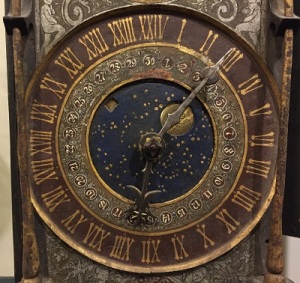
17th century German 24 hour chamber clock with moon phase, NAWCC museum.
International clock and watch collection
Unfortunately for the watch and clock industry, new electronic and less expensive methods were developed to keep time, relegating mechanical clocks and watches to a historical footnote. It is this brief rise to dominance in the craft of watch and clock production that the NAWCC museum captures through an impressive display of both American and European time pieces.
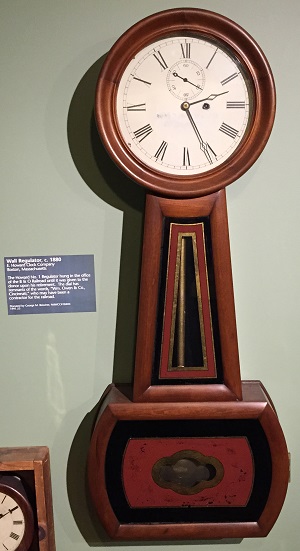
E Howard Number 1 regulator, 1880, NAWCC Museum.
Lots of clocks, little explanation
Museums are, by design, display warehouses of the dead. Just as one wanders around a grave yard reading tomb stones, the descriptive placards next to the clocks shed little light as to the historical significance of the time piece. Like most museums, aficionados and collectors get the most out of the cursory inspection of the specimens on display. To reach and educate more people about mechanical clocks and watches the NAWCC will need to have more docents available for tours, historical explanations along with videos that document watch and clock movements from the basic to the complicated.
Expanded interpretation needed
As my 17 year old son put it after our two hour visit, “I’ve seen enough clocks for a life time”. It’s not that he didn’t appreciate the antiques, but he wanted more information on how the clocks and watches worked. He found the ornate designs of the pocket watches his most favorite display next to the cases of the early American tall case clocks. I enjoyed looking over the rather bland but functional shelf and wall clocks of the mid 1800’s. You can only look at so many clocks hanging on a wall before your brain starts to glaze over. Hence, the museum needs more interactive displays and explanations about the time pieces.
Engle monumental clock

Top half of the Engle monumental clock on display at the National Association of Watch and Clock Collectors Museum.
The best working demonstration was of the Engle monumental clock. The NAWCC has done a wonderful job of restoring and keeping the clock and entertainment piece working. Finally finished in 1878 after twenty years of construction, this machine which is a clock at heart has numerous moving dioramas and music that occur each quarter hour. Engle created a monumental clock that was homage to Christianity, American ingenuity with a healthy dash of patriotism. While it was wonderful to see this giant machine in action, even my son noted that it would have been more fascinating to see the internal working and gears that powered all the figurines and pipe organ.
Time well spent on Americana
If you are passing through Columbia on Highway 30 the NAWCC museum is worth spending a couple hours of your time. Every conceivable contraption to keep time is either documented or on display at the NAWCC museum. No other place has such a concentration of American clock and watch history as this museum. There is also no other institution that is dedicated to preserving the history of American clock making from early craftsmen to industrial lathes, tools and dies as this museum. It’s important that we support such a treasure for future generations.


